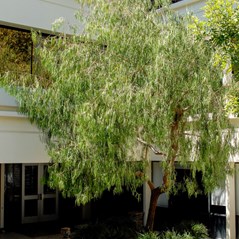Uses: Highly attractive native tree can be used for shade in parks and reserves or wider streetscapes, Needs to be kept back from kerb as weeping foliage can obscure vehicular views.
Flowers are strongly scented citrus
Slow growing, requires well-drained soils.
Has problems competing with Kikuyu and is best not grown in lawned areas.
Can be grown in locations such as roof gardens where constricted roots will constrain size.
Note: This species is classified schedule 1, Regulation 24.2 under the Sewerage Act and may be planted in any street or road in any drainage area provided they are not planted closer than two metres to any sewer main or connection.
This plant is indigenous to the following botanical regions of South Australia.
:EA: Eastern
:MU: Murray
For detail on these regions refer to the user guide.
- Canopy Shape Round
- Height 4-9m
- Spread 5-10m
- Position
- Full Sun
- Family Rutaceae
- Botanical Name Geijera parviflora
- Common Name Wilga Wilga
- Origin SA, Vic, NSW, Qld
- Habit Rounded canopy, Dense, Weeping
- Landscape Coastal footslopes, 2nd line coast, Plains
- Soil Texture Clay, Loam, Sand
- pH Alkaline, Neutral
- Tolerates Drought, Moderate frost
- Supplementary Watering Minimal
- Flower Colour White
- Flowering Time Winter, Spring
- Foliage Mid-green
- Flower Type Star
- Purpose Ornamental, Shade
- Evergreen/Deciduous Evergreen
- Trunk Rough
- Form Medium Tree (Usually between 5m & 11m)
- Indigenous to the Adelaide Region







